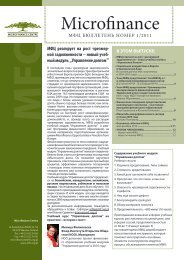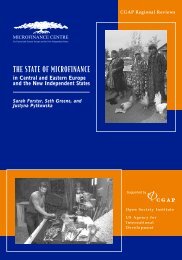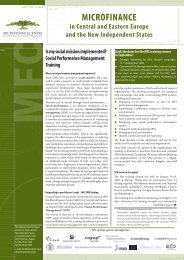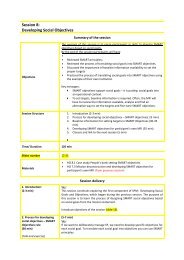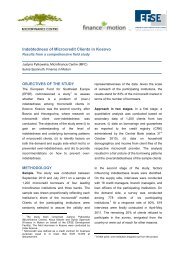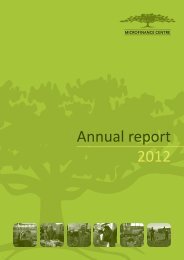Value Chains research report Tajikistan final - Microfinance Centre
Value Chains research report Tajikistan final - Microfinance Centre
Value Chains research report Tajikistan final - Microfinance Centre
You also want an ePaper? Increase the reach of your titles
YUMPU automatically turns print PDFs into web optimized ePapers that Google loves.
Wire and comb foundation are sourced in the domestic market, as well as imported<br />
from Kyrgyzstan. Currently the beekeepers’ associations have equipment for producing<br />
comb foundation.<br />
Aluminum cans are in short supply, they are sold by pieces. Beekeepers need metal<br />
wire and plastic containers for honey. The container must be made of food-grade materials<br />
and have strong handles. Currently beekeepers buy certified barrels in the market.<br />
Beekeepers also need fumigators, brushes, face nets, knives and many other<br />
accessories.<br />
Medications and veterinary medicines. There is a stable demand for such<br />
medicines as bipin, flucin and oxalic acid. Pest control is used at various times, depending<br />
on the disease and location. The price of chemicals for treatment varies substantially<br />
depending on the place it is purchased at. Medications are also imported from Uzbekistan,<br />
while originating in Russia.<br />
Honey packaging process.<br />
Packaging is one of the biggest weaknesses for the honey industry in <strong>Tajikistan</strong>. Currently<br />
the honey is packaged in aluminum cans, 35-40 kg each. These cans have extremely long<br />
history and are not suitable for long-term storage, due to oxidation. In the Soviet times these<br />
cans were produced at Tashkent Aviation Factory, and now they are imported by private<br />
entrepreneurs from Russia. They are not very convenient, but they have no alternative<br />
available. The supply is short and for most part the cans have been used for over 20 years.<br />
Another type of packaging is to pour honey into cardboard boxes lined with PET film. When<br />
honey is stored in a cool room, it is crystallized and remembers the shape of the box. Then<br />
it is sold in bricks in the local market. This type of packaging is used primarily for cotton<br />
honey. Far and large, all cotton producers and beekeepers sell their product in the local<br />
market in plastic or glass containers – jars ranging from 0.2 to 3 liter capacity (see Picture<br />
3). Often honey is sold in glass jars not specifically intended for this product. These are<br />
glass jars used for canned vegetables, often with original labels still attached. In some<br />
European countries (primarily Germany, Czech Republic and Turkey), special food-grade<br />
plastic buckers with twisted tops with the capacity of 25 kg are used for both domestic and<br />
export market. These containers are beginning to arrive to <strong>Tajikistan</strong>, and the demand for<br />
these is unmatched by supply.<br />
Industrial packaging in modern and specialized containers for honey is not present in<br />
<strong>Tajikistan</strong>. The main obstacles for expanding production are financial problems and high<br />
cost of beekeeping accessories (boxes, carts, frames, etc.). Besides, the cost of collecting<br />
honey and maintaining bee yards have increased lately. It could be helpful to get loans for<br />
this purpose in lending organizations.<br />
111




